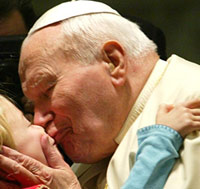 |
 |
 |
 News Around the Republic of Mexico | April 2005 News Around the Republic of Mexico | April 2005  
Boy's Cure Called a Miracle
 Wire services Wire services


| | "God saved me for some destiny, and He knows what that is." |
A man who suffered from leukemia as a boy is crediting Pope John Paul II with performing a lifesaving miracle when the pontiff kissed his head in 1990.

Reports of miracles attributed to John Paul are fueling speculation he soon may be placed on the path to sainthood although for a miracle to be considered in the saintmaking process it has to have occurred after John Paul's death.

José Herón Badillo was 4 when the pope visited his home state of Zacatecas, Mexico; Badillo had received treatment both locally and in Mexico City for leukemia, but the family considered his disease incurable.

But after greeting the pope, he said his disease essentially disappeared.

"He saw me there, with my body weakened, and he asked God to alleviate my condition," Badillo said in a telephone interview. "I felt a very great emotion, a degree of happiness I believe is the greatest possible. It's something hard to describe in words." His family, and their priest, have no doubt it was a miracle.

"We thank God and the pope, because it was through him that the miracle was performed," said Laura Patricia Badillo, 18, his younger sister. "We are so very grateful." José Herón's cure occurred while John Paul was very much alive, meaning it should have little bearing whether the pope is canonized. But that matters little to the family.

"For us, he was a saint from the moment he interceded on our behalf," Badillo said. "His passing was hard for us, but it was easier because we know he went to be with the God. If he helped us so much here on earth, imagine how much greater his intercession will be up there." The documentation on the case has been sent to Rome, said Father Humberto Salinas, a priest from the diocese of northern Zacatecas state who befriended the family.

The boy had been selected in 1990 to hold a dove as part of the airport ceremonies to welcome John Paul. "The family didn't come to ask for anything," said Salinas. "They just wanted him to be near the Pope." "The pope kissed the boy's head. He had lost his hair already, and his face bore the marks of the radiation therapy," Salinas recalled. "The Pope was smiling, and he told the boy to let the dove go." Badillo recalls that before meeting the Pope, "I hadn't eaten anything for 10 or 15 days. After that, I got my appetite back and began to eat." Soon thereafter, he claimed tests showed the disease had disappeared.

"The doctors said it was a rapid and complete recovery," Salinas said. Asked if it was a miracle, Salinas said that "given the life and holiness of John Paul II and the faith of the boy and his family, I don't think there is any reason to doubt it." Mexican Cardinal Javier Lozano Barragán, who headed the Vatican office on health care issues under John Paul, said there was no medical explanation for the boy's recovery.

But doctors at Mexico City's National Pediatric Institute, where the boy was treated, have a somewhat different interpretation.

While the boy's complete recovery might be considered unusual, it may have been simply that the first round of chemotherapy worked and that he was already on the road to recovery when the family took him to see the Pope, the doctors told the Italian newspaper Corriere della Sera.

Still, the continued rounds of chemotherapy doctors usually generally recommend in such cases were never performed and were apparently never needed.

Badillo, now studying in hopes of becoming an engineer, had attended a seminary briefly, but decided he didn't have a vocation. He now leads the life of an average 20-year-old in the cattle- and bean-raising town of Rio Grande, in northern Zacatecas.

"He's a normal person, just like anyone else," said Laura Patricia, his sister.

"God saved me for some destiny, and He knows what that is," Badillo said.

Salinas recalls that a church leader from Zacatecas, on a visit to Rome, once told John Paul about the boy's miraculous recovery; the pope did not say much, but when the story was over, said simply, "God is great and full of marvels." | 
 | |
 |



